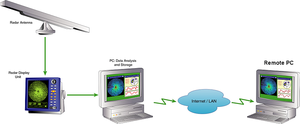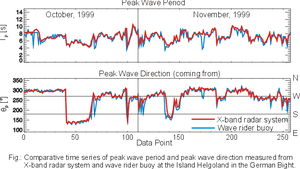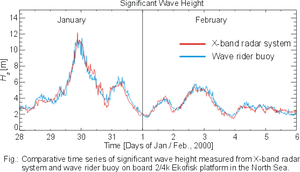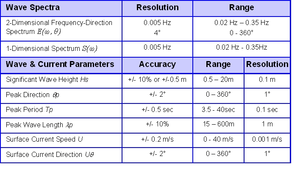Difference between revisions of "Waves and currents by X-band radar"
InaTrankmann (talk | contribs) m (→X-band Radar Systems) |
InaTrankmann (talk | contribs) m (→X-band Radar Systems) |
||
| Line 60: | Line 60: | ||
WaveGuide System: [http://www.radac.nl/] | WaveGuide System: [http://www.radac.nl/] | ||
| − | |||
| − | |||
| − | |||
== References == | == References == | ||
<references/> | <references/> | ||
Revision as of 13:06, 1 April 2007
Many offshore operations are critically dependent on the prevailing sea state. To enhance the safety of people, vessels, buildings and environment, routine sea state measurements are required. In coastal areas sea state measurements are needed to support weather and ship routing services. In addition in recent times, wave data gained growing importance in the protection of the coastal zone from eroding forces of wind, waves, and currents. To meet this increasing demand for sea state information, different wave sensors have been developed in the last decades. Special attention has also been given to the use of various remote sensing techniques to measure waves and surface currents. The ground based remote sensing technique described here is based on standard nautical X-band radar generally used for ship traffic control and navigation purposes. Wave measurements by X-Band radar systems are a reliable data source for supporting e.g. offshore as well as harbour operations or ship routing services.
It is known that under various conditions signatures of the sea surface are visible in the near range (< 3 nm) of nautical radar images. These signatures are known as sea clutter. The sea clutter is generated by hydrodynamic modulation, tilt modulation, and shadowing [1]. It is created by the backscatter of the transmitted electromagnetic waves from the short sea surface ripples (in the range of cm).
As a result, the longer surface gravity waves become visible in the unfiltered video signal of any nautical X-band radar as a stripe-like pattern [2]. The generated radar images contain information about several phenomena, such as the wind speed, the wave tilts, and the wave heights.
The oceanographic measurement systems based on X-band radar allow scanning the ocean surface in real time with high temporal and spatial resolution. A large part of the ocean surface is monitored continuously. These remote sensing systems can be installed on moving vessels as well as on fixed platforms or at coastal sites. Results can be displayed on site or transferred to remote locations via internet.
A typical nautical radar measurement is composed of a temporal sequence of sea clutter images i(x, y; t). In order to derive wave information from these data sets, several steps must be taken.
First, the spatial and temporal dependence of the radar images is transformed into the spectral domain. The transformation to the wave number k = (kx, ky) and wave frequency domain ω, is done by means of a three dimensional discrete Fourier transform (FFT). Hence, the so-called three dimensional image spectrum I(k, ω) is computed [3]. To localize the wave energy in the image spectrum, the two-dimensional surface current U = (Ux, Uy) must be determined. This can be achieved by a linear regression analysis, taking into account the theoretical dependence of the spatial and temporal evolution of linear surface waves.
Once the two dimensional current is computed, the unambiguous wave spectrum F(k) can be calculated by removing all (k, ω) components that do not belong to the wave field [4] [5]. By applying the dispersion relation, the wave number spectrum can be transformed into the frequency-direction spectrum E(ω, θ). The one dimensional frequency spectrum S(ω) is computed by integrating E(ω, θ) over all wave directions.
Contents
Wave Systems
X-Band radar systems are is able to resolve different wave systems: swell and wind sea systems. The wave period representing the limit between swell and wind sea is depending on the wind speed, where swell is characterized by its phase speed being faster than the wind speed (swell waves propagate faster than the wind). Please, see also Waves.
Peak Wave Period and Direction
The peak wave period and direction can be derived from the frequency-direction spectrum E(ω, θ) [6]. Period and direction depend on the peak frequency which is the location of the energy maximum within the spectrum. In order to determine the peak frequency the centroid formula can be used which implies a frequency interval of 80 % energy maximum. This method is recommended by IAHR/ AIRH because of its high stability with respect to theoretical spectral variability. The wave period can also be derived by the spectral moments obtained over the full range of frequencies.
Significant Wave Height
In contrast to in-situ sensors, the wave spectra determined from radar images are not properly scaled. Thus, the total wave energy and the significant wave height cannot be computed directly from these spectral estimates. The significant wave height is determined by using a linear regression equation, which relates the root square of the signal-to-noise ratio of the radar images to the significant wave height [7].
Surface Current Calculation
The surface current is obtained by minimising the distance between the location of the spectral energy in the 3D image spectrum and its theoretical position defined by the dispersion relation for linear surface gravity waves. The surface current is the basic step to calculate directional wave spectra from radar images. Please, see also Currents.
Resolution and Limits
The resolution of sea state measurements of X-band radar systems are limited in time and space. The spatial resolution is limited by the sampling frequency (SFR), antenna opening angle (ФA) and the size of the analysis areas (NX x NY) which are set in the radar image range of view. The temporal resolution is limited by the antenna repetition rate (RPT) and the number of images used for the wave analysis: nt of i(x, y; t).
Output Parameters and Accuracy
The table lists the standard output parameters with corresponding resolutions, ranges, and accuracies. These values indicate typical ranges. The numbers depend on the radar hardware, the total time of measurement and therefore can vary for each individual installation.
X-band Radar Systems
Examples of X-band Radar Systems:
WaMoS II Wave and Surface Current Monitoring System: [1]
WAVEX Wave Monitoring System: [2]
SeaDarQ system: [3]
WaveGuide System: [4]
References
- ↑ Alpers, W.; Ross, D.B., and Rufenach, C.L., 1981: On the Detectability of Ocean Surface Waves by Real and Synthetic Aperture Radar. Journal of Geophysical Research, 86, C7, pp. 6481-6498.
- ↑ Plant, W.J. and W.C. Keller, 1990: Evidence of Bragg scattering in microwave Doppler spectra of sea return, J.Geophys. Res., 95(C9), 16,299-16,310.
- ↑ Young, I.R.; Rosenthal, W., and Ziemer, F., 1985. A Three-dimensional analysis of marine radar images for the determination of ocean wave directionality and surface currents. J. Geophys. Res., 90, pp. 1049 -1059.
- ↑ Seemann, J., 1997. Interpretation of the Structure of the frequency-wave number spectrum of nautical radar temporal sequences of sea states (in German). Hamburg, Germany: University of Hamburg, Ph.D. thesis.
- ↑ Nieto, J.C.; Hessner, K., and Reichert, K., 1999. Estimation of the Significant Wave Height with X-Band Nautical Radars. Proceedings of the 18th OMAE Conference, St John’s, New Foundland, Canada.
- ↑ Young, I.R.; Rosenthal, W., and Ziemer, F., 1985. A Three-dimensional analysis of marine radar images for the determination of ocean wave directionality and surface currents. J. Geophys. Res., 90, pp. 1049 -1059.
- ↑ Nieto, J.C.; Reichert, K., and Dittmer, J., 1998. Use of Nautical Radar as a Wave Monitoring Instrument. Coastal Engineering, 37, pp. 331-342.





